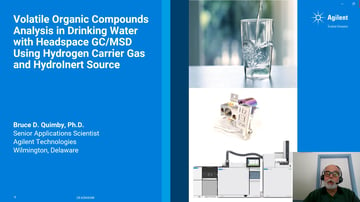
Separation Science, in collaboration with
Agilent, offers a video application, complementary application note and related assets focused on volatile organic compounds analysis with headspace GC/MSD and hydrogen carrier gas and HydroInert source.
Format: Video Application
Duration: 38 minutes
Presenter: Bruce D. Quimby, PhD
Bruce D. Quimby, PhD
Senior Applications Scientist, Agilent
Dr Bruce Quimby is a Senior Applications Scientist in the Mass Spectrometry Division of Agilent Technologies, located in Wilmington, Delaware. He is currently working in GC/MS applications in multiple areas including environmental and food safety.
Sponsor:



 Analysis of Semivolatile Organic Compounds with Hydrogen Carrier Gas and HydroInert Source by Gas Chromatography/Triple Quadrupole Mass Spectrometry (GC/MS/MS)
Analysis of Semivolatile Organic Compounds with Hydrogen Carrier Gas and HydroInert Source by Gas Chromatography/Triple Quadrupole Mass Spectrometry (GC/MS/MS) Analysis of Semivolatile Organic Compounds Using Hydrogen Carrier Gas and the Agilent HydroInert Source by Gas Chromatography/Mass Spectrometry
Analysis of Semivolatile Organic Compounds Using Hydrogen Carrier Gas and the Agilent HydroInert Source by Gas Chromatography/Mass Spectrometry Agilent Inert Plus GC/MS System with HydroInert Source Applying H2 carrier gas to real-world GC/MS analyses
Agilent Inert Plus GC/MS System with HydroInert Source Applying H2 carrier gas to real-world GC/MS analyses Agilent EI GC/MS Instrument Helium to Hydrogen Carrier Gas Conversion - User Guide
Agilent EI GC/MS Instrument Helium to Hydrogen Carrier Gas Conversion - User Guide